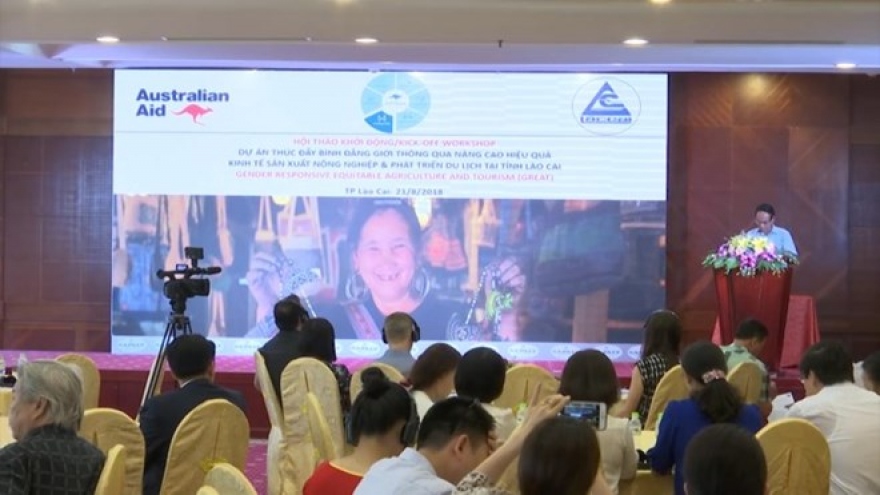Gender equality: the competitive edge of business
Babeth Ngoc Han Lefur, country director of Oxfam in Vietnam, offers an insight into how far Vietnam has gone in promoting equality between men and women.
 |
Vietnam was among the first countries to ratify the UN’s Convention on the Elimination of All Forms of Discrimination against Women (CEDAW) on women’s rights in 1982, and the Vietnamese women’s labour force participation of over 73 per cent is one of the highest in the region. And yet Vietnamese women are mostly found in unskilled and untrained labour-intensive sectors.
They earn 33 per cent less on average than their male counterparts in all fields, with the biggest difference of 43 per cent found in agriculture and foreign companies. In the government, only one out of 20 ministers, and 89 out of 1048 department directors are female.
Globally, more men than women own land, shares, and other capital assets, men are paid more for filling the same roles as women, and men are concentrated in higher paid jobs.
The unpaid care work that hugely contributes to the world’s economic prosperity is unrecognised and unrewarded, keeping women subordinate and restrained in their choices.
In the social enterprise sector, Southeast Asia is leading the way on pay parity and leadership opportunities for women compared to all other regions, and yet women in Asia earn a fraction of men’s wages and are more likely to be paid below the minimum wage.
There is compelling evidence that women in leadership in companies drive profits and give businesses a competitive edge. On a national level, greater gender equality in the workforce provides enormous macroeconomic opportunities.
The McKinsey Global Institute asserted in 2015 that if women participated equally in the global economy, they could generate additional GDP worth $28 trillion by 2025. This amount is roughly equivalent to the size of the Chinese and US economies combined.
In order for government and business leaders to do better, they must begin by addressing three key barriers to economic equality:
-
Agree that the idea that ‘our economic model is gender-neutral’ is a myth. Instead, the policy environment needs to revalue and redistribute care work to end the double burden that many women face.

Babeth Ngoc Han Lefur, country director of Oxfam in Vietnam - Women’s economic empowerment is a practical selling point for companies and businesses, but is not enough to demonstrate a commitment to change corporate culture—the entrenched structures that undermine women’s access to resources, assets, and leadership positions.
- The biggest barrier to change is often the deeply-held social norms, beliefs, and behaviours within companies and organisations’ own practices. Policies are important, but are valueless if not applied consistently.
Pragmatically or even intuitively, Asian business leaders understand that economic equality can only be achieved by ending gender inequalities, but the how is evasive.
A useful framework for companies’ diagnosis, planning, and interventions, called the Rao-Kelleher framework, considers organisational strategy in four dimensions: individual attitudes, access to resources, cultural norms, and formal laws/policies. These dimensions relate to and build on each other.
Change in formal rules and policies is necessary to put accountability mechanisms in place within the organisation’s mission and mandate, ensuring that gender equality is a priority in business decisions, as well as policies for work-family balance and to fight sexual harassment.
Along with this, staff need access to resources, space, and time to advance equality, with more women in leadership positions, training and capacity building opportunities for achieving gender equality goals. This is built on leaders’ and employees’ knowledge and commitment to gender equality and capacity for dialogue.
Finally, change in informal norms and practices is a long-term process involving power sharing, the acceptance of women’s leadership, work-family balance, and inclusive organisational cultures that prioritise learning and prevent harassment and discrimination.
In Vietnam, the legal environment provides a good foundation for companies to develop comprehensive gender policies within their organisations as well as in business operations.
The bigger and more complex task is to enhance gender diversity thinking and culture at the workplace, such as discouraging gender stereotyping, penalising gender discrimination, and promoting values and behaviours of equality and diversity.
Businesses that genuinely strive for inclusion tackle the solution with a comprehensive inside/outside strategy, including good policies, a business culture that values women’s leadership, and contributions to shared prosperity in society.
Businesses’ competitive edge does not come only from the maximisation of profits: it lies in gender diversity and environmental sustainability that drive business growth.
On the occasion of the World Economic Forum on ASEAN, Oxfam launches a discussion paper entitled ‘The Future of business: Shaping inclusive growth in Southeast Asia’ that presents a spectrum of responsible business models that can help to deliver more sustainable and inclusive economic development, zooming on gender equalities at work. The paper will be released on September 11.


